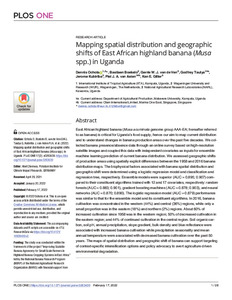| dc.contributor.author | Ochola, D. |
| dc.contributor.author | Boekelo, B. |
| dc.contributor.author | van de Ven, G.W. |
| dc.contributor.author | Taulya, G. |
| dc.contributor.author | Kubiriba, J. |
| dc.contributor.author | Van Asten, P. |
| dc.contributor.author | Giller, K. |
| dc.date.accessioned | 2023-03-22T10:37:27Z |
| dc.date.available | 2023-03-22T10:37:27Z |
| dc.date.issued | 2022-02-17 |
| dc.identifier.citation | Ochola, D., Boekelo, B., van de Ven, G.W., Taulya, G., Kubiriba, J., van Asten, P. & Giller, K. (2022). Mapping spatial distribution and geographic shifts of east African highland banana (Musa spp.) in Uganda. PloS ONE, 17(2): 0263439, 1-28. |
| dc.identifier.issn | 1932-6203 |
| dc.identifier.uri | https://hdl.handle.net/20.500.12478/8101 |
| dc.description.abstract | East African highland banana (Musa acuminata genome group AAA-EA; hereafter referred to as banana) is critical for Uganda’s food supply, hence our aim to map current distribution and to understand changes in banana production areas over the past five decades. We collected banana presence/absence data through an online survey based on high-resolution satellite images and coupled this data with independent covariates as inputs for ensemble machine learning prediction of current banana distribution. We assessed geographic shifts of production areas using spatially explicit differences between the 1958 and 2016 banana distribution maps. The biophysical factors associated with banana spatial distribution and geographic shift were determined using a logistic regression model and classification and regression tree, respectively. Ensemble models were superior (AUC = 0.895; 0.907) compared to their constituent algorithms trained with 12 and 17 covariates, respectively: random forests (AUC = 0.883; 0.901), gradient boosting machines (AUC = 0.878; 0.903), and neural networks (AUC = 0.870; 0.890). The logistic regression model (AUC = 0.879) performance was similar to that for the ensemble model and its constituent algorithms. In 2016, banana cultivation was concentrated in the western (44%) and central (36%) regions, while only a small proportion was in the eastern (18%) and northern (2%) regions. About 60% of increased cultivation since 1958 was in the western region; 50% of decreased cultivation in the eastern region; and 44% of continued cultivation in the central region. Soil organic carbon, soil pH, annual precipitation, slope gradient, bulk density and blue reflectance were associated with increased banana cultivation while precipitation seasonality and mean annual temperature were associated with decreased banana cultivation over the past 50 years. The maps of spatial distribution and geographic shift of banana can support targeting of context-specific intensification options and policy advocacy to avert agriculture driven environmental degradation. |
| dc.description.sponsorship | Bill & Melinda Gates Foundation |
| dc.format.extent | 1-28 |
| dc.language.iso | en |
| dc.subject | Bananas |
| dc.subject | Fruit Crops |
| dc.subject | Geography |
| dc.subject | Machine Learning |
| dc.subject | Geographical Distribution |
| dc.subject | Crops |
| dc.subject | Uganda |
| dc.title | Mapping spatial distribution and geographic shifts of east African highland banana (Musa spp.) in Uganda |
| dc.type | Journal Article |
| cg.contributor.crp | Roots, Tubers and Bananas |
| cg.contributor.affiliation | International Institute of Tropical Agriculture |
| cg.contributor.affiliation | Wageningen University and Research Centre |
| cg.contributor.affiliation | National Agricultural Research Laboratories, Uganda |
| cg.coverage.region | Africa |
| cg.coverage.region | East Africa |
| cg.coverage.country | Uganda |
| cg.coverage.hub | Eastern Africa Hub |
| cg.researchtheme | Natural Resource Management |
| cg.identifier.bibtexciteid | OCHOLA:2022a |
| cg.isijournal | ISI Journal |
| cg.authorship.types | CGIAR and developing country institute |
| cg.iitasubject | Agronomy |
| cg.iitasubject | Banana |
| cg.iitasubject | Food Security |
| cg.iitasubject | Plant Breeding |
| cg.iitasubject | Plant Production |
| cg.iitasubject | Value Chains |
| cg.journal | PLoS ONE |
| cg.notes | Open Access Journal; Published online: 17 Feb 2022 |
| cg.accessibilitystatus | Open Access |
| cg.reviewstatus | Peer Review |
| cg.usagerightslicense | Creative Commons Attribution 4.0 (CC BY 0.0) |
| cg.targetaudience | Scientists |
| cg.identifier.doi | https://doi.org/10.1371/journal.pone.0263439 |
| cg.iitaauthor.identifier | Dennis Ochola: 0000-0003-0179-3607 |
| cg.iitaauthor.identifier | Godfrey Taulya: 0000-0002-5690-0492 |
| cg.iitaauthor.identifier | Piet van Asten: 0000-0003-0584-3552 |
| cg.futureupdate.required | No |
| cg.identifier.issue | 2 |
| cg.identifier.volume | 17 |

